Walnut Pesto Pasta Salad
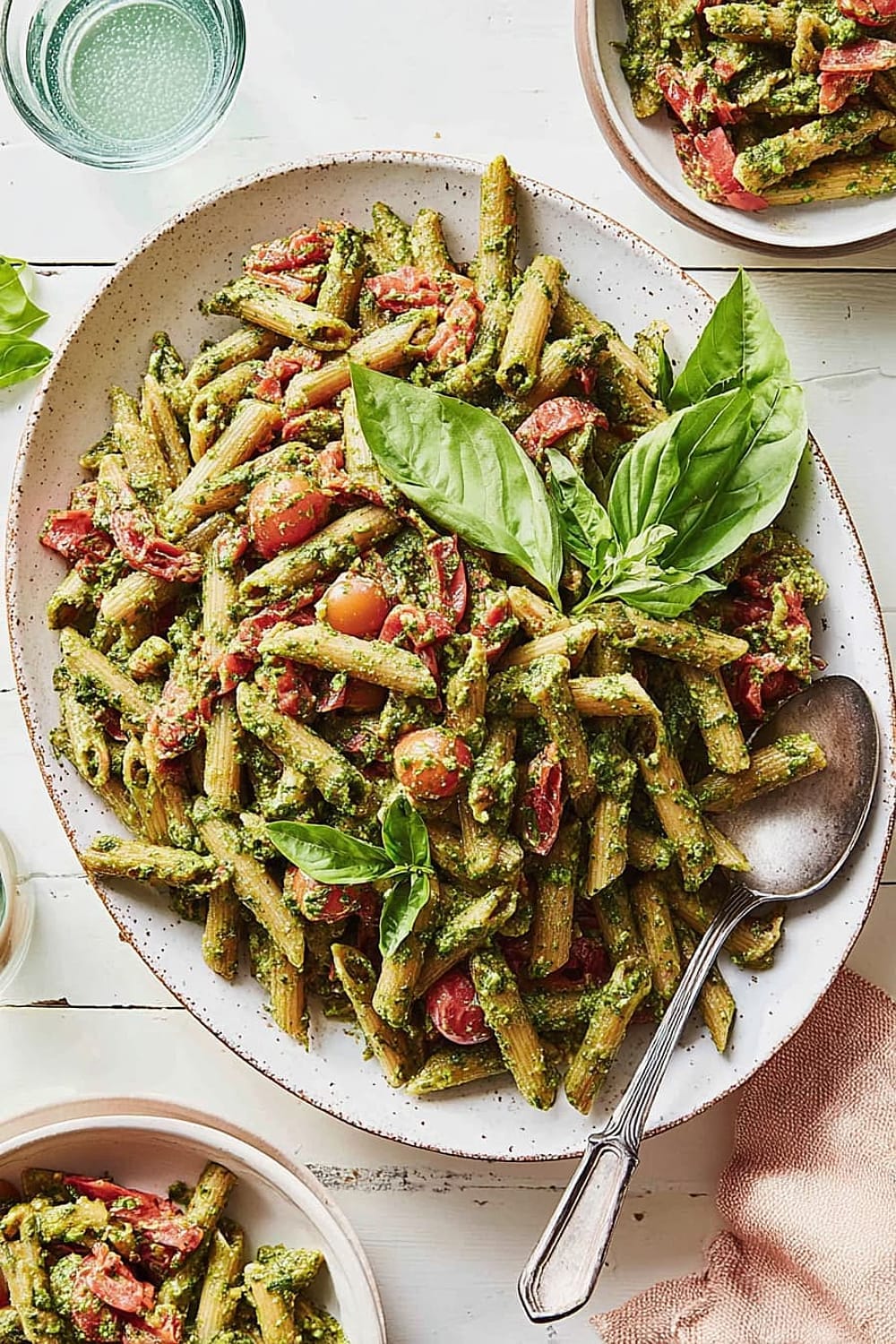
This walnut pesto pasta salad is basically the overachiever of summer sides – it looks fancy enough for company but requires zero actual cooking skills beyond boiling water and pressing buttons on a food processor.
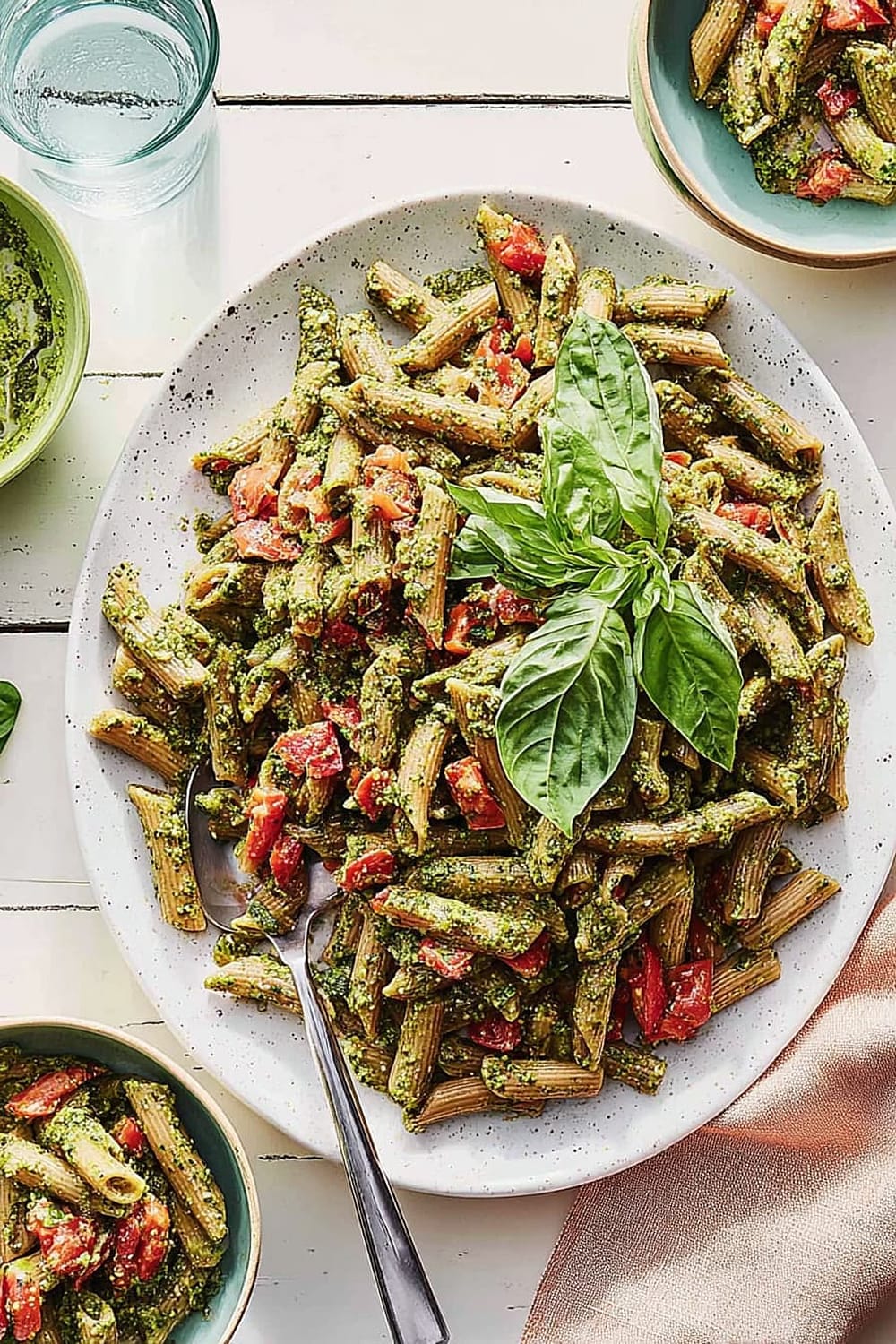
The secret weapon here is swapping traditional pine nuts for toasted walnuts, which gives you that same rich, nutty depth but without the heart attack-inducing price tag at the grocery store.
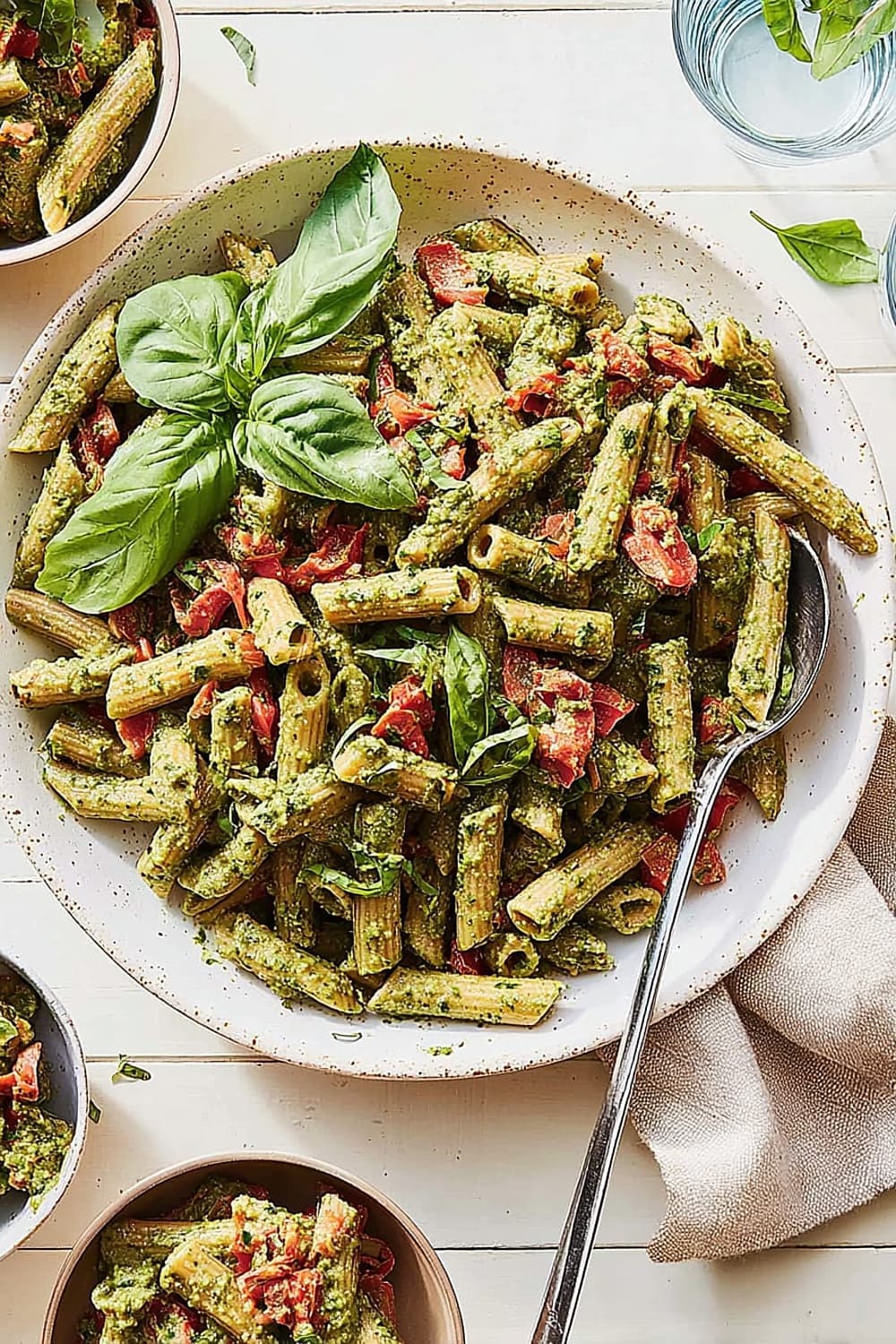
Picture this: tender whole-wheat pasta coated in a vibrant green pesto that’s so aromatic, your neighbors will start “accidentally” dropping by around dinnertime.
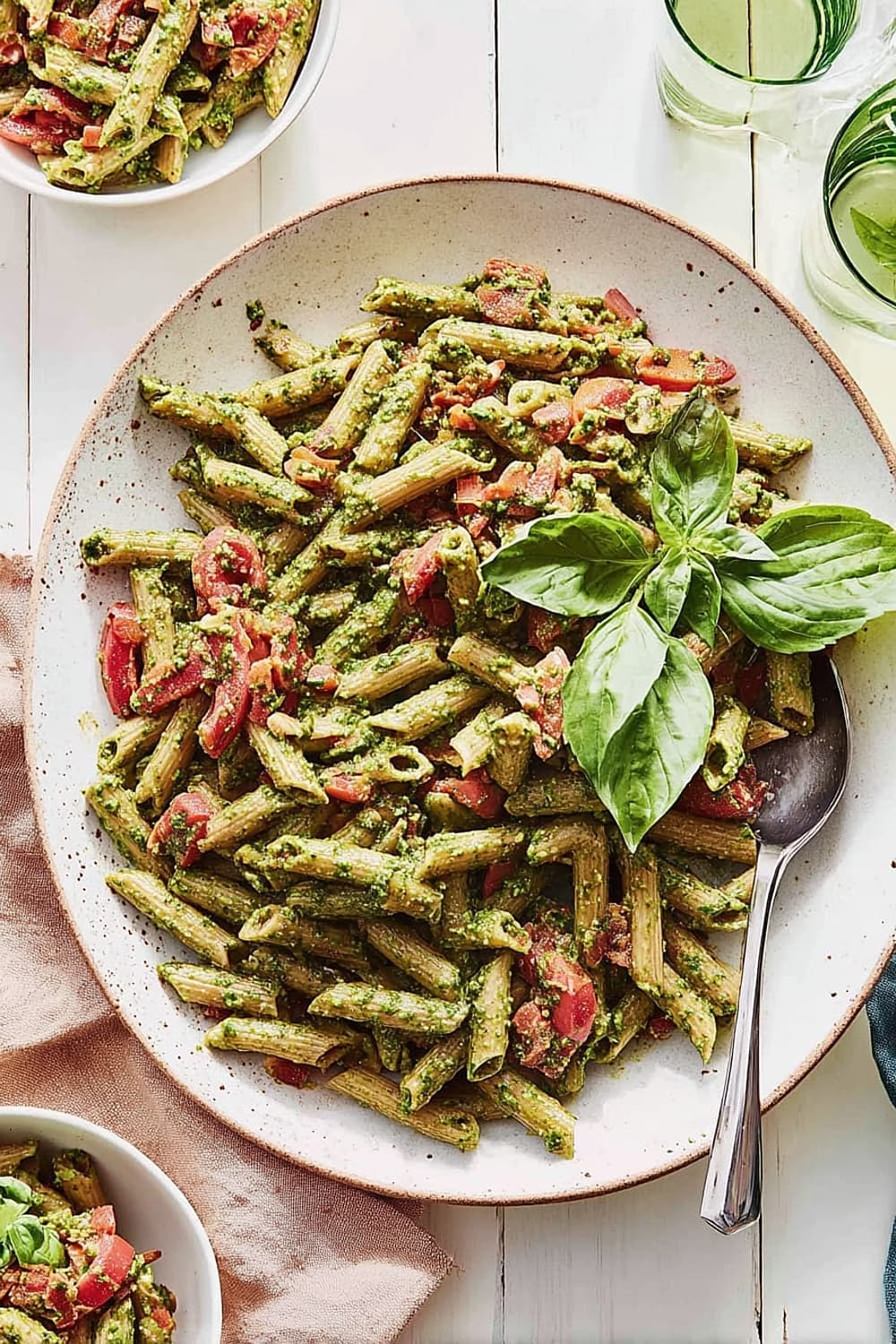
The beauty of this recipe is that it actually gets better as it sits, making it the perfect make-ahead dish for those times when you want to look like you have your life together without the stress-sweating.
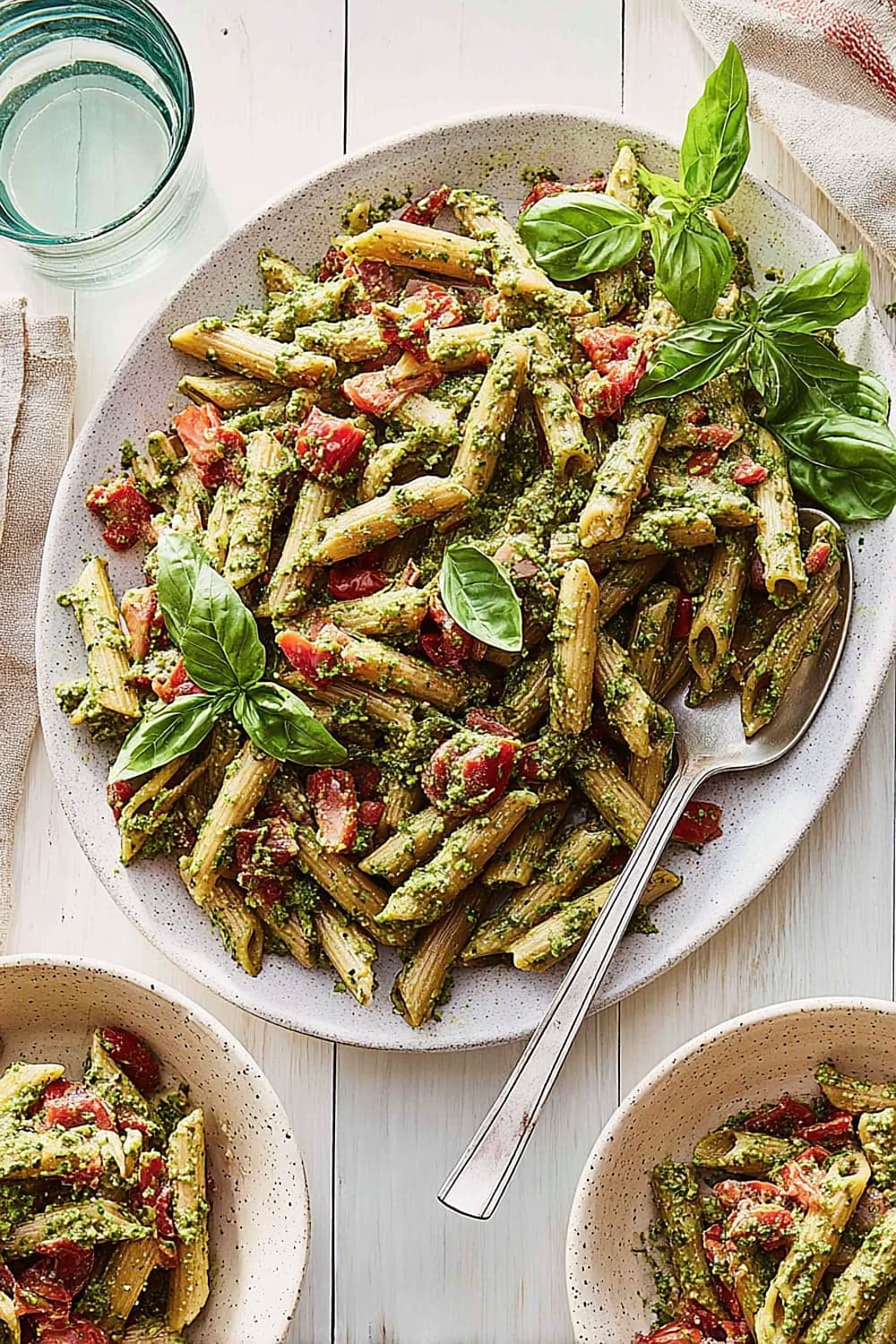
Every bite delivers that perfect balance of herbaceous basil, sharp Parmesan, and crunchy walnuts, with bursts of sweet tomato and smoky roasted red peppers that’ll have people asking for the recipe.
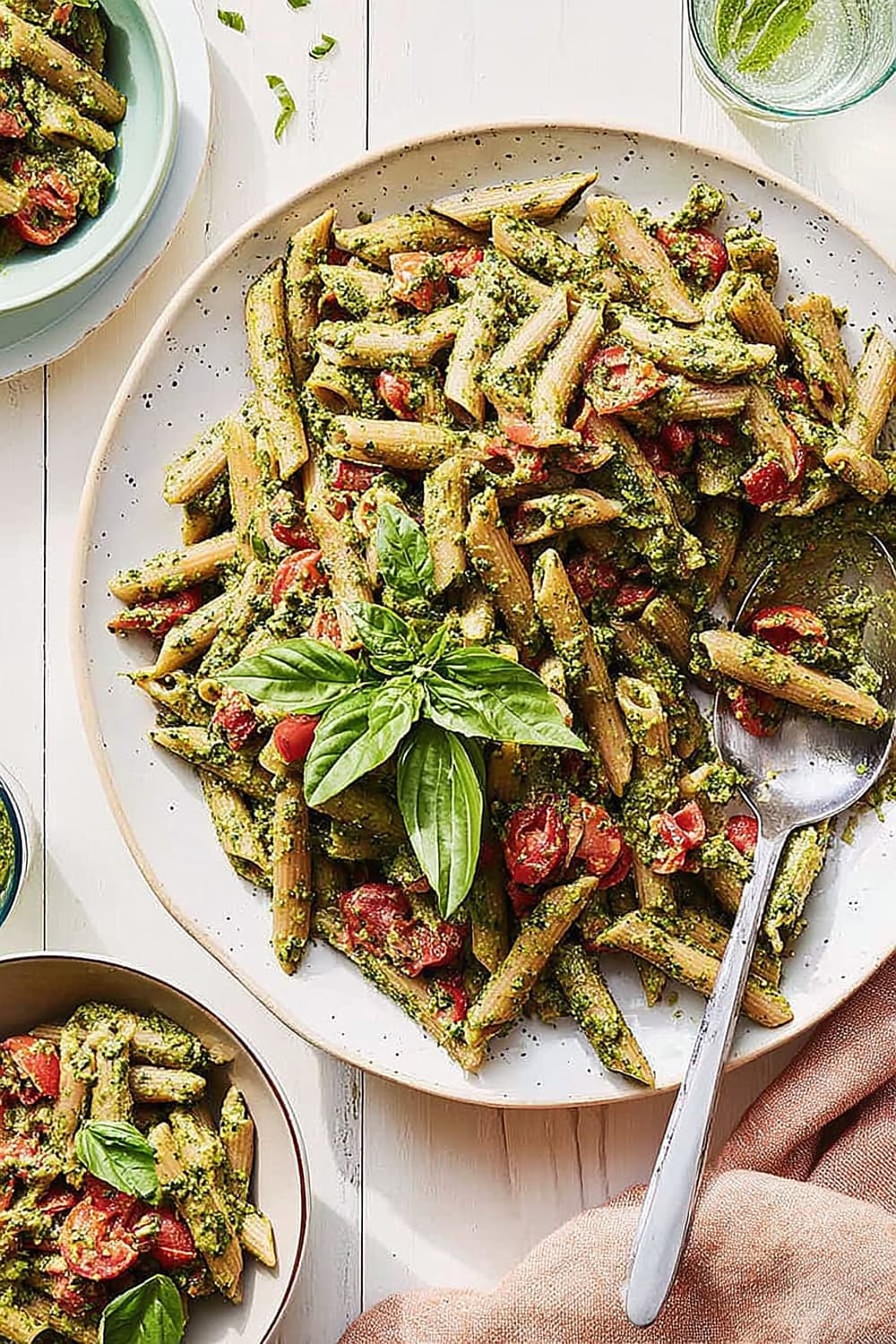
This is the kind of dish that transforms a basic potluck contribution into the star of the table, and honestly, who doesn’t need that kind of culinary confidence boost?
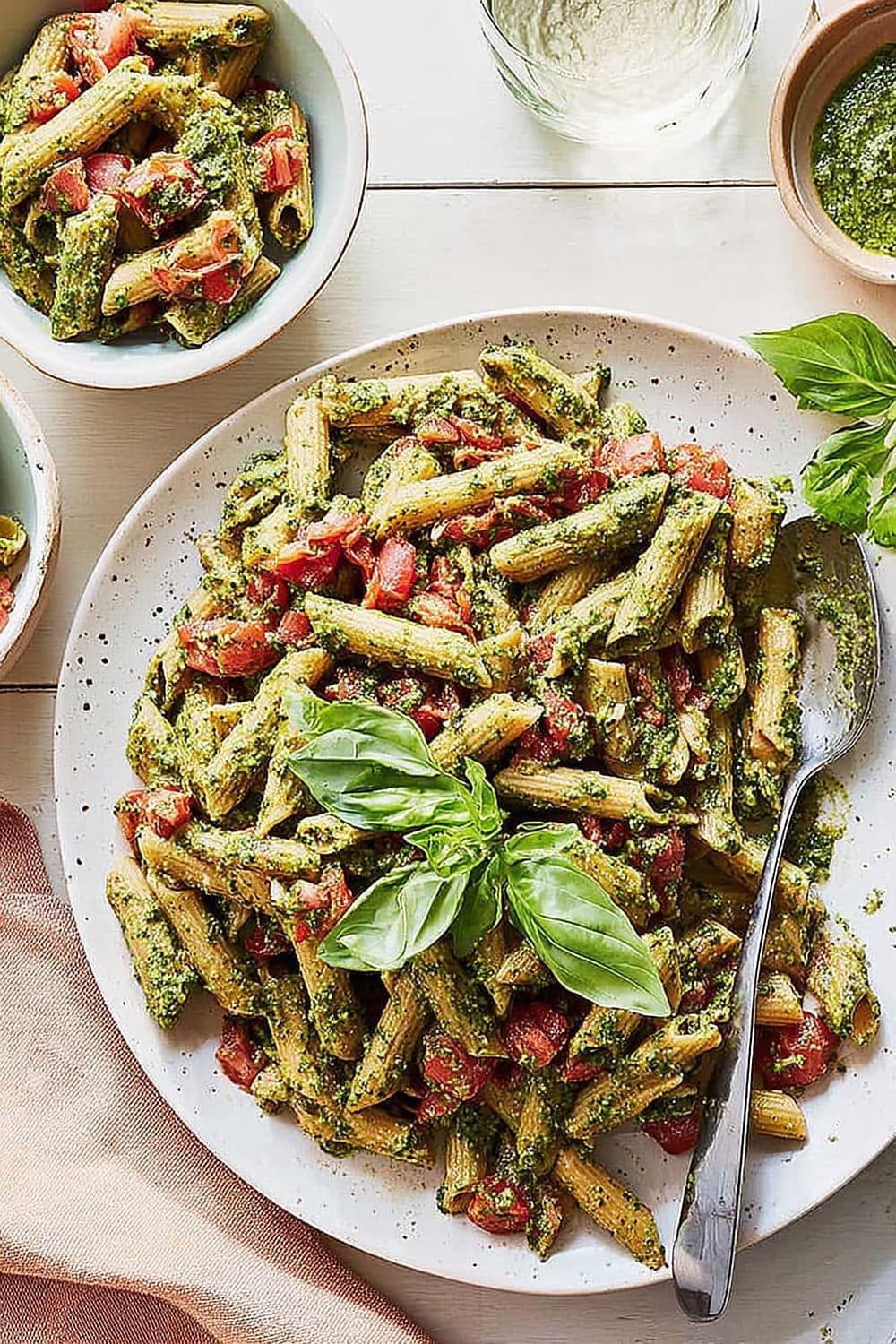
Ingredients
For the pasta base
- 1 pound whole-wheat penne or rotini pasta
- 1 medium tomato, chopped
- ½ cup chopped jarred roasted red peppers, rinsed
For the walnut pesto
- 2 cups lightly packed fresh basil leaves, plus more for garnish
- ½ cup lightly packed flat-leaf parsley leaves
- ½ cup chopped walnuts, toasted
- ½ cup grated Parmesan cheese
- 1 clove garlic, grated
- 1 tablespoon fresh lemon juice
- 1 teaspoon salt
- ¼ teaspoon ground pepper
- ½ cup extra-virgin olive oil
Instructions
Prepare the pasta
- 1 Bring a large pot of water to a boil over high heat. The water should be at a rolling boil before adding the pasta to ensure even cooking and prevent sticking.
- 2 Cook pasta according to package directions until al dente, typically 8-10 minutes for whole-wheat pasta. Test a piece – it should have a slight bite but not be crunchy in the center.
- 3 Drain the pasta thoroughly and rinse with cold water until completely cooled. This stops the cooking process and removes excess starch that could make your salad gummy.
Make the walnut pesto
- 4 While the pasta cooks, combine basil, parsley, toasted walnuts, Parmesan cheese, grated garlic, lemon juice, 1 teaspoon salt, and ¼ teaspoon pepper in a food processor fitted with the metal blade.
- 5 Pulse the mixture 8-10 times, scraping down the sides as necessary, until everything is finely chopped but not completely smooth – you want some texture remaining for the best mouthfeel.
- 6 With the food processor motor running, slowly drizzle in the ½ cup extra-virgin olive oil through the feed tube. Process until the pesto reaches a smooth, spreadable consistency that coats the back of a spoon.
Assemble the salad
- 7 Transfer the freshly made pesto to a large mixing bowl – one that’s big enough to toss everything without making a mess.
- 8 Add the cooled pasta, chopped tomato, and rinsed roasted red peppers to the bowl with the pesto.
- 9 Toss everything together using large serving spoons or tongs until every piece of pasta is evenly coated with the vibrant green pesto. The salad should look glossy and well-distributed.
- 10 Taste and adjust seasoning if needed – you might want a pinch more salt or a squeeze of fresh lemon juice to brighten the flavors.
- 11 Garnish with additional fresh basil leaves just before serving for a pop of color and fresh herb aroma.
Recommended Equipment and Kitchen Tools
Essential Tools (for best results)
- Food processor – A quality food processor makes all the difference in achieving the perfect pesto texture. The metal blade chops herbs evenly and creates that smooth, emulsified consistency when you drizzle in the olive oil.
- Large mixing bowl – You’ll need plenty of room to toss the pasta without flinging pesto everywhere. A wide, shallow bowl works better than a deep one.
- Fine-mesh strainer – Essential for thoroughly draining and rinsing the pasta. The fine mesh prevents pasta from escaping while allowing water to drain quickly.
- Microplane grater – For perfectly grated garlic that distributes evenly throughout the pesto without any harsh chunks.
Helpful Upgrades
- Kitchen scale – Measuring herbs by weight rather than volume gives more consistent results, especially if you’re making this recipe regularly.
- Silicone spatula – Perfect for scraping down the food processor sides and getting every bit of pesto out of the bowl.
Nice-to-Have Options
- Large serving tongs – Makes tossing the pasta salad much easier and more elegant than using two spoons.
- Storage containers – Glass containers with tight-fitting lids keep this salad fresh and are perfect for meal prep portions.
Recipe Variations and Dietary Modifications
Gluten-Free Adaptation
- Replace whole-wheat pasta with 1 pound gluten-free pasta made from rice, corn, or legumes
- Cook gluten-free pasta 1-2 minutes less than package directions as it can become mushy quickly
- Rinse thoroughly with cold water to remove excess starch, which is more prevalent in gluten-free varieties
- Add an extra 2 tablespoons of olive oil to prevent sticking
Dairy-Free Modifications
- Substitute Parmesan with ½ cup nutritional yeast for a cheesy flavor
- Add an extra 2 tablespoons toasted walnuts to compensate for the missing richness
- Include 1 teaspoon white miso paste for additional umami depth
- Increase lemon juice to 2 tablespoons to brighten the flavors
Vegan Version
- Follow dairy-free modifications above
- Ensure pasta is egg-free (most dried pasta is naturally vegan)
- Add 1 tablespoon tahini to the pesto for extra creaminess and protein
Low-Carb Alternative
- Replace pasta with 2 pounds spiralized zucchini or yellow squash
- Salt the spiralized vegetables and let drain for 30 minutes, then pat dry
- Use the same pesto recipe but reduce olive oil to 6 tablespoons
- Reduces carbs from approximately 45g to 8g per serving
Flavor Variations
- Mediterranean twist: Add ½ cup chopped Kalamata olives and ¼ cup sun-dried tomatoes
- Protein boost: Toss in 2 cups cooked chickpeas or 1 pound grilled chicken
- Seasonal summer: Include 1 cup fresh corn kernels and 1 diced avocado
- Herb variations: Replace half the basil with fresh spinach, arugula, or mint
Nutritional Information and Health Benefits
Key Nutritional Highlights
This walnut pesto pasta salad provides approximately 385 calories per serving with a balanced macronutrient profile. Each serving contains roughly 18g protein, 52g carbohydrates, and 14g healthy fats. The whole-wheat pasta contributes 6g fiber per serving, supporting digestive health and helping maintain steady blood sugar levels. The combination of walnuts and olive oil provides heart-healthy monounsaturated and omega-3 fatty acids.
Health Benefits of Main Ingredients
Fresh basil is rich in antioxidants like flavonoids and volatile oils that have anti-inflammatory properties. The herb also contains vitamin K, essential for bone health, and manganese, which supports metabolism. Walnuts are nutritional powerhouses, providing alpha-linolenic acid (ALA), a plant-based omega-3 fatty acid that supports brain health and may reduce cardiovascular disease risk. They’re also excellent sources of protein, fiber, and magnesium. Extra-virgin olive oil contains oleic acid and polyphenols that may help reduce inflammation and support heart health. The Parmesan cheese adds calcium and high-quality protein, while the tomatoes provide lycopene, a powerful antioxidant that becomes more bioavailable when combined with healthy fats.
Dietary Considerations
This recipe contains gluten from wheat pasta and dairy from Parmesan cheese. It’s naturally vegetarian and provides a good balance of plant-based proteins. The high fiber content from whole-wheat pasta and vegetables makes this a satisfying dish that helps maintain stable energy levels. A 1-cup serving provides about 15% of daily fiber needs and 20% of daily protein requirements for most adults.
Smart Swaps and Ingredient Substitutions
Common Substitutions:
- Walnuts → ½ cup pine nuts, pecans, or almonds (toast any nuts for 5-8 minutes at 350°F for best flavor)
- Whole-wheat pasta → Regular pasta, chickpea pasta, or lentil pasta using the same 1 pound amount
- Fresh basil → 1 cup fresh spinach plus 1 cup fresh basil, or 2 tablespoons dried basil (though fresh is strongly recommended)
- Parmesan cheese → ½ cup Pecorino Romano, aged Asiago, or nutritional yeast for dairy-free option
Budget-Friendly Swaps:
- Extra-virgin olive oil → ¼ cup olive oil plus ¼ cup neutral oil like avocado or grapeseed oil
- Jarred roasted red peppers → 1 large red bell pepper, roasted and peeled yourself
- Fresh herbs → 3 tablespoons frozen basil cubes (found in freezer section) thawed and drained
Pantry Emergency Substitutions:
- Fresh lemon juice → 1 tablespoon white wine vinegar or apple cider vinegar
- Fresh garlic → ¼ teaspoon garlic powder or 1 teaspoon garlic paste
- Roasted red peppers → ½ cup chopped sun-dried tomatoes or 1 diced red bell pepper
Pro Tips for Substitutions:
- When using different nuts, maintain the ½ cup measurement but adjust salt slightly as some nuts are naturally saltier
- If using dried herbs, add them to the oil first and let sit for 10 minutes to rehydrate before processing

Make It Diabetes-Friendly
Carb Reduction Strategies:
- Replace 1 pound whole-wheat pasta with 12 ounces pasta plus 4 ounces spiralized zucchini to reduce carbs by approximately 15g per serving
- Use ¾ pound chickpea or lentil pasta instead of wheat pasta to increase protein and fiber while maintaining similar carb content
- Serve ¾ cup portions instead of 1 cup to reduce carbs from 52g to 39g per serving
Portion & Blood Sugar Management:
- Recommended serving size: ¾ cup (approximately 39g carbs)
- Ideal timing: Serve as a side dish with 4-6 ounces grilled protein to slow carb absorption
- Pairing suggestions: Serve with 2 cups mixed greens salad and 1 tablespoon olive oil dressing to add fiber and healthy fats
Enhanced Nutrition Modifications:
- Add 1 cup cooked white beans to increase protein and fiber, helping stabilize blood sugar
- Include 1 diced cucumber and 2 tablespoons chopped fresh herbs for extra fiber and volume without additional carbs
- Increase walnut content to ¾ cup for more protein and healthy fats
Total Carb Reduction: Modified version contains approximately 35g carbs per serving compared to 52g in the original recipe.
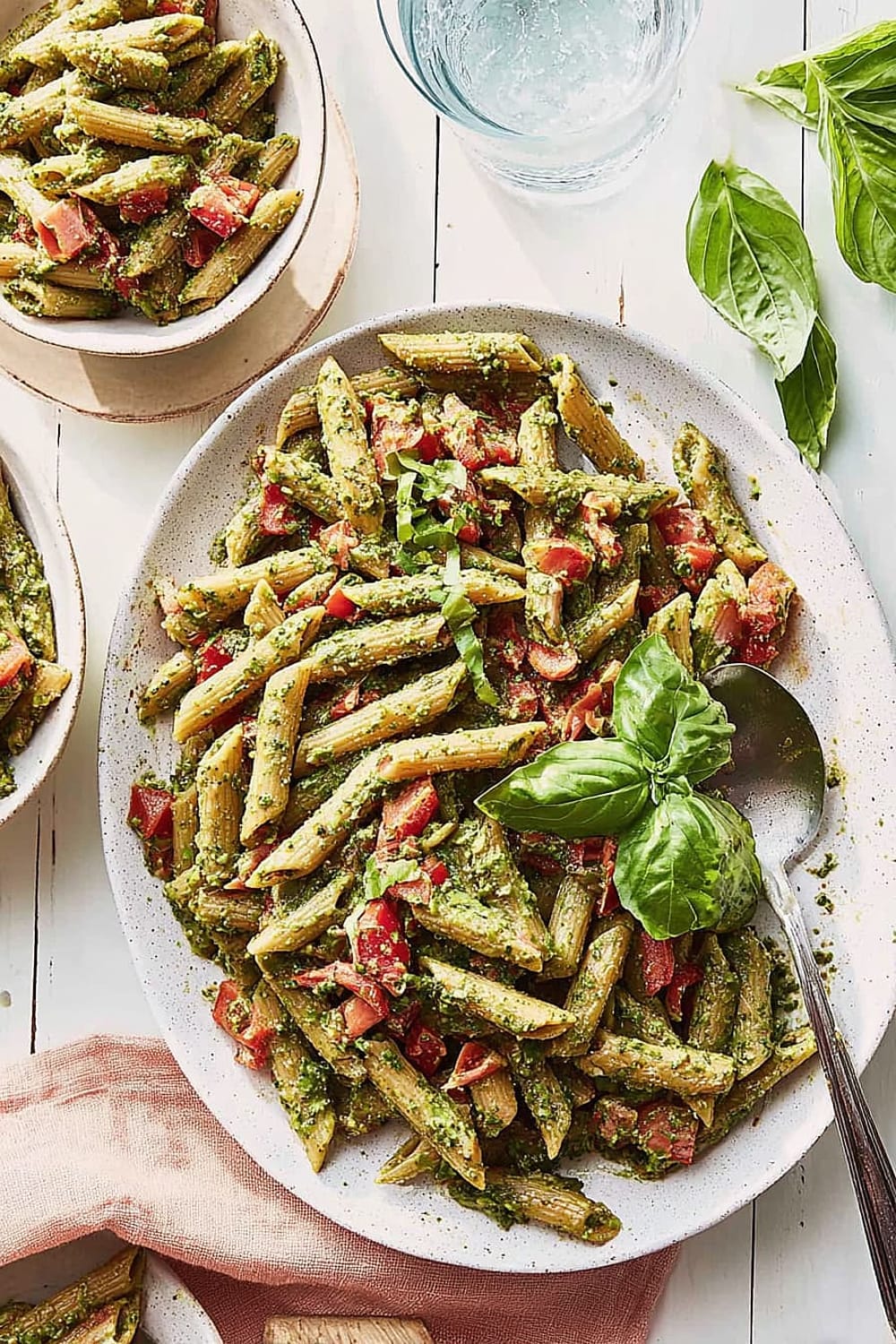
Perfect Pairing Suggestions
Beverage Pairings
This herbaceous pasta salad pairs beautifully with crisp white wines like Sauvignon Blanc or Pinot Grigio, whose acidity complements the lemon and herbs while cleansing the palate between bites. For red wine lovers, a light Chianti or Sangiovese works wonderfully with the Italian flavors. Beer enthusiasts should try a wheat beer or light lager that won’t overpower the delicate herb flavors. Non-alcoholic options include sparkling water with lemon, iced green tea, or a refreshing cucumber mint agua fresca that echoes the fresh herb theme.
Side Dish Recommendations
Grilled vegetables like zucchini, eggplant, and bell peppers create a perfect Mediterranean spread while adding smoky flavors that complement the pesto. A simple arugula salad with lemon vinaigrette provides peppery contrast to the rich pasta. Crusty sourdough bread or focaccia is ideal for soaking up any extra pesto. For protein, grilled chicken thighs, salmon, or Italian sausage turn this side into a complete meal.
Complete Meal Ideas
Start with a antipasto platter featuring olives, fresh mozzarella, and prosciutto. Follow with this pasta salad alongside grilled protein and roasted seasonal vegetables. End with fresh berries and a light lemon sorbet. For casual entertaining, serve family-style with multiple salads, grilled meats, and plenty of crusty bread.
Occasion Suggestions
Perfect for summer barbecues, potluck dinners, and picnics since it travels well and doesn’t require reheating. Ideal for meal prep lunches or light dinners. The elegant presentation makes it suitable for dinner parties when served in individual portions garnished with fresh basil.
Pro Tips and Troubleshooting
Professional Techniques
Salt your pasta water generously – it should taste like seawater. This is your only chance to season the pasta itself. When making pesto, add ingredients to the food processor in order of hardness: nuts and garlic first, then herbs, then cheese, and finally oil. This ensures even chopping and prevents the herbs from becoming bruised. Toast your walnuts until fragrant and lightly golden for maximum flavor impact – this takes 5-7 minutes at 350°F.
Common Mistakes and Solutions
If your pesto looks separated or oily, you added the oil too quickly. Fix it by processing 2 tablespoons of the mixture with 1 tablespoon warm water, then slowly add back the separated pesto. Pasta that’s too soft ruins the texture – aim for al dente since it continues softening as it sits. If the salad seems dry after chilling, stir in 1-2 tablespoons extra olive oil and a squeeze of fresh lemon juice.
Storage and Make-Ahead
This salad keeps for 3-4 days refrigerated in an airtight container. The flavors actually improve after 2-4 hours of chilling. For meal prep, store in individual containers for up to 4 days. Don’t add tomatoes until serving if making more than 24 hours ahead, as they can make the salad watery. Bring to room temperature for 15 minutes before serving for best flavor.
Scaling Tips
This recipe doubles easily for crowds. When making larger batches, process the pesto in two batches to ensure even consistency. For parties, consider making the pesto 1 day ahead and storing it with plastic wrap pressed directly onto the surface to prevent browning.
This walnut pesto pasta salad proves that impressive doesn’t have to mean complicated – sometimes the best recipes are the ones that let quality ingredients shine with minimal fuss, creating something that tastes like it took hours but actually fits into your real life.